It’s been just over a month since I last wrote a blog and in that time much has changed in the garden. The majority of my vegetables have been planted out into the patch with only some nasturtiums and lettuce occupying the greenhouse. The birds are back too, we’re very lucky to have an array of different birds including finches, wagtails and woodpeckers. I’m sure there are many more but without a bird book I’m not entirely sure what they are. The tomatoes and peppers have recently gone in, and are looking good so far. Some plants are faring better than others though, the potatoes have taken off but my peas, garlic and sweetcorn are having a hard time. I’m hoping that a little food and regular watering will sort it all out. If not, we’ll be eating none of their produce in the months to come.
One of the things I have to keep in mind when I search for perfection in year one, is that this is all an experiment. I don’t know what will grow well, I don’t know what we’ll eat, I don’t know what I’ll grow again next year, but over the course of this year I’ll find the answers to those and make some notes on how to improve next year.
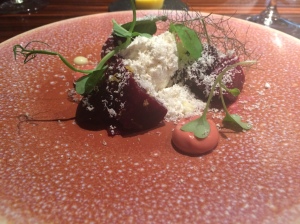
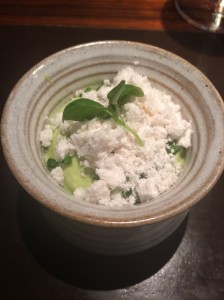
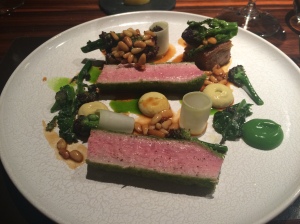
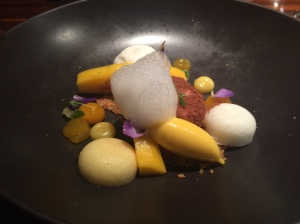
As I’ve been busy with this work stuff, including jetting off to Dublin every other week, I haven’t had as much time for cooking as I’d have liked. That said, the enticing fresh produce of spring has meant that whenever I’ve had a spare moment I’ve been cooking with the joys of spring. This last month’s highlights include slow roast chicken with lemon and thyme, vanilla panna cotta with strawberry jelly, duck breast with cavolo nero and asparagus, roast leg of lamb with roast new potatoes, beetroot, peas and courgette and sous vide strawberries with granny smith apple sorbet and shortbread biscuit. Nick and I also enjoyed lunch at L’autre Pied; it’s always such an inspiration to eat out at amazing restaurants, to see the flavour combinations, new techniques and ideas (amuse bouche to dessert above).
Slow Roast Lemon and Thyme Chicken with Roast Vegetables
This recipe takes a long time from start to finish. But it is well worth it, it’s from How to Cook Like Heston and is the most amazing roast chicken I’ve ever eaten. As the chicken is slow cooked and brined before it maintains all the juicy flavours and is incredibly succulent. The advice is also to remove the wishbone prior to cooking, as it makes the breast a lot easier to carve. By slicing the meat as I’ve done (see below) it allows for the muscle fibres to be cut across, making it melt in the mouth.
Ingredients
Whole chicken – size is dependent on how many people you need to feed or how much you want for leftovers
6% brine solution, (I used 150g in 2.5ℓof water) make sure it’s enough to cover the chicken
Butter (lots)
Thyme
1 lemon
White wine
Potatoes
Duck fat
Courgettes
Carrots
Seasoning
Method
Make the brine mixture and put into a large pan with the chicken, making sure that the chicken is covered fully. Put into the fridge overnight.
Remove from the fridge and pat the chicken dry with kitchen towel, then take 100g of soft butter and massage into the chicken. Put roll and pierce the lemon and put into the cavity, along with a few sprigs of thyme. Put onto a roasting tray and into an oven at 90°c (70°c fan) for 3-4 hrs. When the thickest part of the breast is 60°c (using a meat thermometer) remove the chicken from the oven and cover with foil.
In this time, peel and par boil the potatoes and carrots for 10-15min. Fluff the potatoes so the outsides go crispy and coat with duck fat, about 2-3tbsp should be fine. Season well and pop into the oven at 200°c for an hour, turning occasionally.
Make a basting sauce from 20g butter, 50ml wine and a couple of sprigs of thyme. Heat this in a saucepan so the ingredients combine and whilst the chicken is resting, baste this mixture over the top regularly.
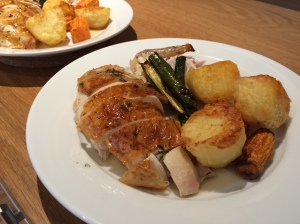 Slice the courgettes in half and roast for 20-30min, depending on the size of your courgettes.
Slice the courgettes in half and roast for 20-30min, depending on the size of your courgettes.
After 45min resting, heat the oven to full whack and put the chicken back in for 10 – 15min until the skin is crispy and golden.
To make a light sauce, use the chicken juices and combine with a little wine, a tsp Dijon mustard and a couple of sprigs of parsley. Heat together then spoon over the chicken once served.
Slice the breasts off whole from the chicken and then slice again width ways (see below). Serve with the veggies and a couple of spoonfuls of the sauce. A perfect spring chicken meal.
Vanilla Panna Cotta with Strawberry Jelly
I first saw this on a Junior Masterchef Australia episode and have taken the idea but changed the recipe slightly. The first one I made was very rubbery and didn’t have that amazing creamy mouth feel that a panna cotta should have. I heard somewhere that a panna cotta when turned out should be wobbly like Homer’s belly (as in The Simpsons, not the ancient Greek poet!). The strawberry jelly provides freshness, and with some delicious Kentish strawberries in season now, it’s the perfect time to make it.
Ingredients (makes 4)
For the strawberry jelly
150g fresh strawberries
100ml water
30g caster sugar
2 gelatine leaves (4g)
For the panna cotta
2 gelatine leaves (4g)
250ml milk
250ml double cream
1tsp vanilla extract
25g caster sugar
Method
For the strawberry jelly, chop up the strawberries into small pieces, saving one or two for decoration. Put into a large glass bowl and add the water and sugar. Place over a pan of simmering water, making sure the bowl does not touch the water. Heat gently and mash the strawberries so that the flavour is extracted.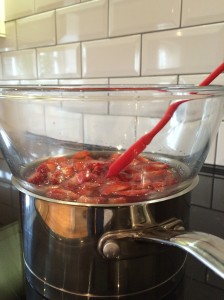
Put the gelatine leaves (2 of them) into a jug of cold water and leave for 5min.
Once the strawberry flavour has infused into the water (taste to make sure), strain the fruit from the liquid, then squeeze out the water and add the gelatine leaves. Put back over the heat for a couple of minutes to combine, when place a few tablespoons into each of the four moulds. Place in the fridge to cool and set for a few hours.
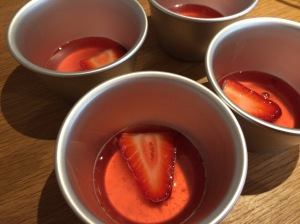 Once set, make the panna cotta by heating the milk, cream, vanilla and sugar. Again, soak the gelatine leaves in a jug of cold water. Once the cream and milk mixture is simmering, remove from the heat, then squeeze the water out of the gelatine leaves and add to the pan. Stir to combine fully, then once cooled slightly, add to the jelly in the moulds.
Once set, make the panna cotta by heating the milk, cream, vanilla and sugar. Again, soak the gelatine leaves in a jug of cold water. Once the cream and milk mixture is simmering, remove from the heat, then squeeze the water out of the gelatine leaves and add to the pan. Stir to combine fully, then once cooled slightly, add to the jelly in the moulds.
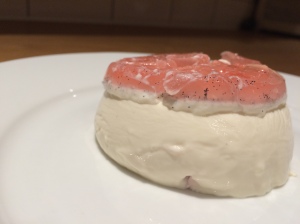 To serve, take a small pallet knife or spatula if your moulds are metal, and slide down the side of each one to break the seal. Turn upside down and pop onto a plate to serve.
To serve, take a small pallet knife or spatula if your moulds are metal, and slide down the side of each one to break the seal. Turn upside down and pop onto a plate to serve.
Sous Vide Strawberries with Granny Smith Sorbet and Shortbread Biscuit
Following a house warming party last weekend, we’ve spent the majority of the week (happily) eating leftovers. With some left over apples from apple bobbing which everyone was a little nervous about, and some strawberries that managed to avoid the Pimms jug I thought I’d make a fresh spring like dessert to go with dinner.
Ingredients
5 granny smith apples, peeled and cored
Juice of 2 lemons
200g caster sugar
250ml water
100g strawberries
20ml white wine (frozen)
5g caster sugar
55g butter
25g caster sugar
90g plain flour
Method
For the apple sorbet, chop the apples into relatively small pieces, then cover with the lemon juice, stirring to coat all the pieces, then put into a plastic dish into the freezer.
Make the stock syrup by combining the 200g caster sugar and 250ml water and bring to the boil gently. Once boiling remove from the heat.
Add the stock syrup to the frozen apples and blend into a liquid mixture, then put into the ice cream machine to churn for around 30min. Remove and put into a plastic container in the freezer to fully set.
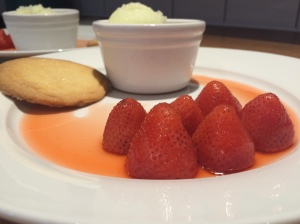 To make the shortbread, combine the butter, caster sugar and plain flour in a bowl, then press together with your hands. Roll out to around 7mm thick, then cut into your desired shape with a cutter or knife. Bake in the oven on a non-stick mat for 15-20min then cool on a wire rack.
To make the shortbread, combine the butter, caster sugar and plain flour in a bowl, then press together with your hands. Roll out to around 7mm thick, then cut into your desired shape with a cutter or knife. Bake in the oven on a non-stick mat for 15-20min then cool on a wire rack.
For the sous vide strawberries, freeze the wine in a small container in the freezer. This is just to prevent the vacuum machine from sucking it out when it removes the air.
Place the whole strawberries (green leaves and stems removed) along with the frozen wine and 5g caster sugar into a sous vide bag and vacuum and seal. Heat the sous vide machine to 85°c then cook for 15min.
Serve for the fresh tastes of a British spring!
So hopefully the next few weeks will see some edible produce coming out of the vegetable patch, I have to admit I’m really looking forward to tasting it. I’m also looking forward to having some colour in the garden. We have a few roses which are beautiful but I’ve just planted a bunch of wild flower seeds and some non-wild flowers seeds too. Two oak trees have also just been planted from germinated acorns we found when making the vegetable patch. So with a healthy glow of a tan, hint of pretty garden optimism and the smell of a slow cooked lam shoulder in the oven, I’m off for another week or few. Hope you’re enjoying spring as much as I am.



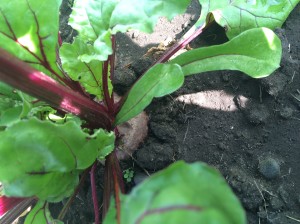
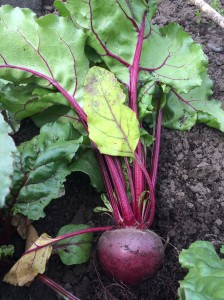

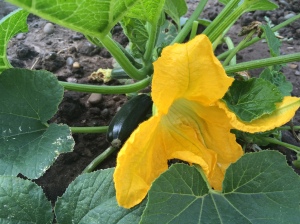
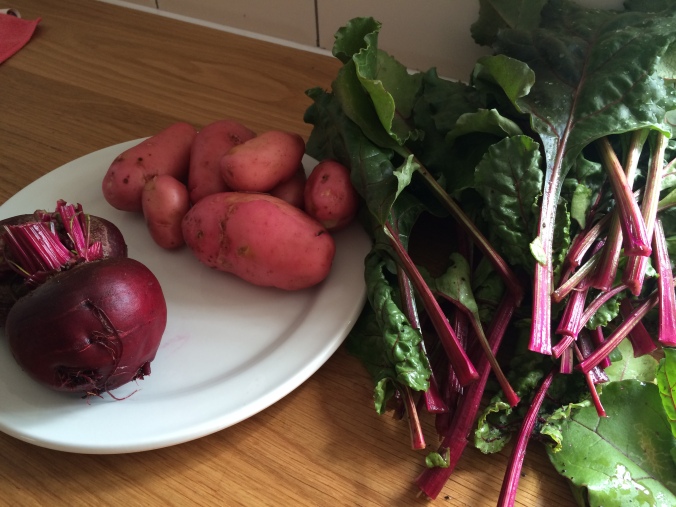
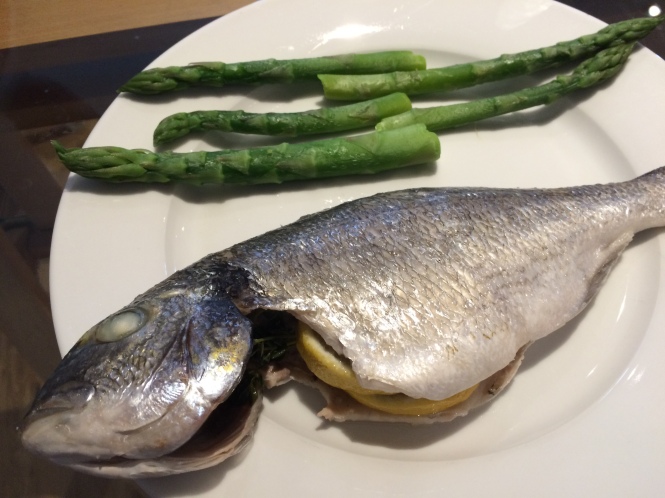








 To serve, take a small pallet knife or spatula if your moulds are metal, and slide down the side of each one to break the seal. Turn upside down and pop onto a plate to serve.
To serve, take a small pallet knife or spatula if your moulds are metal, and slide down the side of each one to break the seal. Turn upside down and pop onto a plate to serve.